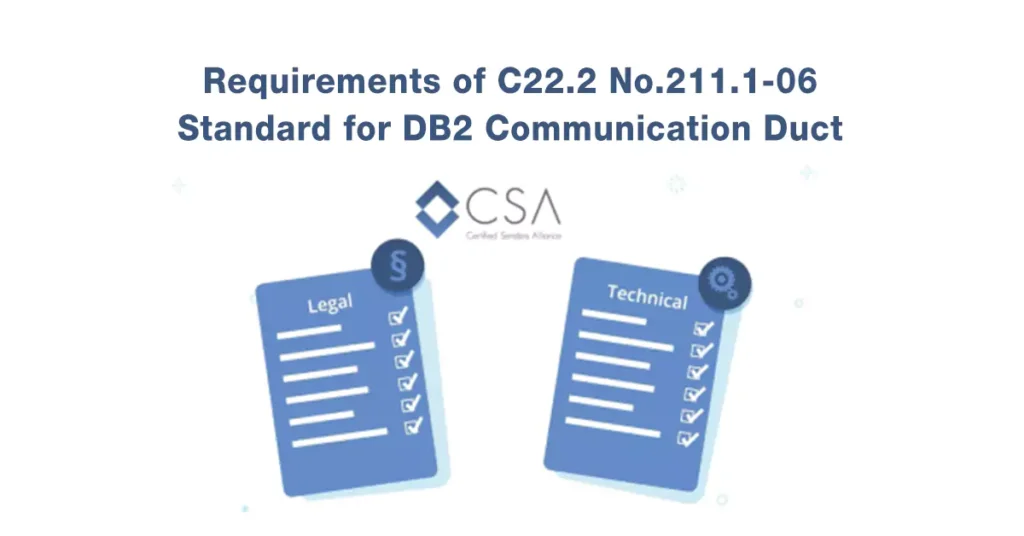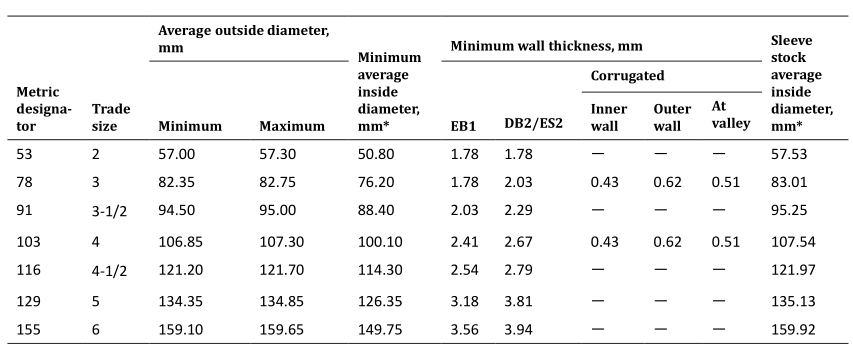
Table of Contents
The C22.2 No.211.1-06 standard plays a pivotal role in providing essential guidelines for evaluating the performance and ensuring the safety aspects of DB2 PVC conduit. This particular standard is applicable to two distinct types of rigid PVC conduit, namely EB1, designed for encasement in concrete or masonry, and DB2/ES2, intended for direct burial or encasement in concrete or masonry. Additionally, it encompasses the associated fittings, all of which must adhere to the regulations outlined in the Canadian Electrical Code, Part I, specifically for ordinary locations. By adhering to this standard, customers can confidently assess the quality and reliability of the DB2 PVC conduit while maintaining a consistent understanding of expectations related to performance and safety measures.
The relevant standard test methods and table data mentioned in this text are sourced from the CSA C22.2 No.211.1-06 and ASTM official standard documents for reference purposes.
Diameter & Wall Thickness:
In order to comply with the standards set forth in the official document C22.2 No.211.1-06, conduit must fulfill the necessary requirements for diameter and wall thickness, as measured in accordance with ASTM D 2122.
For multi-layer conduit, the individual inner and outer layers must have a minimum thickness of 10% of the specified wall thickness mentioned in below Table. In addition, the center layer of the multi-layer conduit should have a contrasting color when compared to the inner and outer layers.

Diameter & Wall Thickness Requirements for Rigid PVC Conduit
The maximum allowable difference between the outside diameter and the measured average outside diameter should not exceed 2% according to the standards outlined in ASTM D 2122.
When assessing the straightness of the conduit, the deviation should not exceed 10 mm per meter, as measured in accordance with ASTM D 2122.
Included Test Requirements:
Conditioning
To ensure consistent results, all conduit and fittings must undergo a conditioning process in accordance with ASTM D 618. This involves subjecting them to a controlled environment with a temperature of 23 ± 2°C and a relative humidity of 50 ± 5% for a minimum of 40 hours. The purpose of conditioning is to establish a standardized baseline for testing, ensuring that all specimens are exposed to the same temperature and humidity conditions.
Impact Resistance
Conduit is subjected to impact testing following Method A of Clause 6.3.1 in CSA C22.2 No. 211.0. This test evaluates the ability of the conduit to withstand impacts without cracking or splitting. The impact energy used during testing is 61 J at a temperature of 23°C and 34 J at a temperature of -18°C.
During the impact test, ten specimens are tested at each temperature. It is important to note that at least nine out of the ten specimens should not exhibit any visible cracking or splitting on the inside or outside of the conduit, which can be observed using normal or corrected-to-normal vision. This ensures that the conduit maintains its structural integrity and can withstand potential impacts without compromising its performance and safety.
Crush Resistance
To assess the conduit’s ability to withstand crushing forces, five specimens are subjected to testing at a temperature of 23 ± 2 °C, as specified in Clause 6.9 of CSA C22.2 No. 211.0. The test measures the percentage decrease in diameter for each specimen, both under load and after recovery.
The average values are then calculated and compared to specific limits. For type EB1, the average percentage decrease in diameter under load should not exceed 12%, while for type DB2/ES2, it should not exceed 10%. Furthermore, the average percentage decrease in diameter after recovery should not exceed 5% for either type. These criteria ensure that the conduit can withstand crushing forces without significant deformation.
Coupling Crush
The strength of the coupling is evaluated through a coupling crush test, as outlined in Clause 6.10 of CSA C22.2 No. 211.0. This test involves a visual examination using normal or corrected-to-normal vision to detect any cracks or signs of failure.
Additionally, the coupling is crushed between two parallel plates, with the plates being at least 3 mm longer than the coupling itself. The crushing process is carried out at a constant rate, gradually reducing the inside diameter of the coupling to 50% of its original size. The duration of the test spans between 2 and 5 minutes.
The purpose of this test is to determine the coupling’s ability to withstand crushing forces without exhibiting any cracks or failures. By ensuring the coupling remains intact during the test, it can be deemed suitable for use, providing reliable connections within the conduit system.
Residual Stress Test
To assess the dimensional stability of two specimens, a test is conducted following Method A of Clause 6.12.1 in CSA C22.2 No. 211.0. The objective is to ensure that the internal vertical diameter of each specimen does not decrease by more than 0.5%.
Here are the steps involved in the test:
- Each specimen is prepared to a length of 250 ± 3 mm.
- The vertical inside diameter of each specimen is measured and recorded.
- The specimens are placed in an oven that has been preheated to 65 ± 2 ℃, ensuring that the measured vertical inside diameter remains in the vertical position. The specimens are then kept inside the oven at 65 ± 2 ℃ for a duration of 4 hours.
- After 4 hours, the oven door is opened, and the specimens are allowed to cool to 23 ± 2 ℃ inside the oven.
- The specimens are then removed from the oven, and the vertical inside diameter is remeasured. The percentage change in diameter is calculated by comparing the initial measurement with the final measurement.
By following these steps, the test helps determine if the specimens maintain their dimensional stability when exposed to elevated temperatures. It ensures that the internal vertical diameter does not undergo excessive contraction, verifying the suitability of the specimens for their intended application.
Chemical Resistance
To evaluate the chemical resistance of the test specimens, a chemical resistance test is conducted following the guidelines specified in CSA B137.0. The aim is to ensure that the specimens undergo a mass change of no more than 2% when exposed to the specified solutions listed in Table below. The immersion period lasts for 7 days.
After the immersion period, each sample is used to prepare both test and control specimens. The apparent tensile strength of these specimens is determined in accordance with CSA B137.0. The tests are performed within 1 hour of removing a sample from the reagent. At least three test specimens are taken from each large sample and subjected to testing at a crosshead speed of 12.7 mm/min ± 25%.
The average tensile strength of the test specimens is then compared to the average tensile strength of the control specimens. The acceptable difference between these two averages should not exceed 15%. This criterion ensures that the chemical exposure does not significantly affect the tensile strength of the specimens, indicating their ability to resist chemical degradation and maintain their structural integrity.
By conducting these tests and adhering to the specified parameters, the chemical resistance of the specimens can be accurately assessed, ensuring their suitability for applications where exposure to various chemicals is expected.

Chemical Resistance Test Requirement
Joint Tightness
To assess the tightness of a joint, a test is conducted following Method A of Clause 6.11.2 in CSA C22.2 No. 211.0. The purpose is to determine if the joint can withstand water pressure for a specified duration without rupturing.
Here are the steps involved in the test:
- Two lengths of conduit, each measuring 1 ± 0.1 meters, are solvent-cemented to a coupling. The assembly is then allowed to cure for 24 hours at room temperature.
- Suitable closures are applied to the ends of the conduit to create a sealed assembly.
- The assembly is filled with water, ensuring that all air is properly evacuated.
- A gauge pressure of 35 kPa is applied to the assembly for a duration of 4 hours.
By subjecting the joint to this water pressure test, its tightness is evaluated. The goal is to verify that the joint can withstand the specified pressure without any leakage or failure. This test ensures that the joint is securely sealed, providing reliable containment and preventing water or fluid from escaping the conduit system.
Stiffness
To assess the stiffness of the conduit, a test is conducted following the guidelines of ASTM D 2412. For type EB1 conduit, it should have a minimum pipe stiffness of 200 kPa, while type DB2/ES2 conduit should have a minimum pipe stiffness of 300 kPa. This test measures the ability of the conduit to resist deformation under a specified deflection of 5%.
Bond Strength
The bond strength of a conduit specimen is evaluated by attempting to cleanly separate the inner and outer walls at the corrugation valley using a sharp probe or knife point. The test is performed at eight equally spaced points around the circumference of the conduit.
The test is considered successful if it is not possible to cleanly separate the walls. This indicates a strong bond between the inner and outer walls, ensuring the integrity and structural stability of the conduit. By conducting this test, the ability of the conduit to maintain its structural integrity and resist delamination is assessed, providing assurance of its reliability and durability.
The C22.2 No.211.1-06 standard is crucial for ensuring the quality and safety of DB2 PVC conduit. This standard establishes a comprehensive framework of testing parameters and requirements that guarantee the conduit’s adherence to essential performance standards. By evaluating various aspects such as flame resistance, impact resistance, crush resistance, flexibility, pullout strength, and environmental resilience, the standard ensures that DB2 PVC conduit is reliable, durable, and suitable for a wide range of electrical applications.
Complying with these stringent requirements not only enhances the safety of electrical installations but also contributes to the overall efficiency and effectiveness of electrical systems. The standard ensures that the DB2 PVC conduit can withstand potential hazards, such as flames and impacts, while maintaining its structural integrity. It also verifies that the conduit has the necessary flexibility and crush resistance to endure challenging environmental conditions. Additionally, the standard evaluates the conduit’s pullout strength, ensuring secure and reliable connections.
By adhering to the C22.2 No.211.1-06 standard, manufacturers can provide high-quality DB2 PVC conduit that meets the rigorous demands of electrical installations. And LEDES, as one of leading electrical conduit supplier in China, certainly obtained this CSA certificate. This, in turn, instills confidence in the reliability and durability of the conduit, promoting the safety and efficiency of electrical systems as a whole.
Contact
If you have any questions or are interested in our products, you can contact us by submitting the contact form. Our sales team will reply to your message within one working day.



